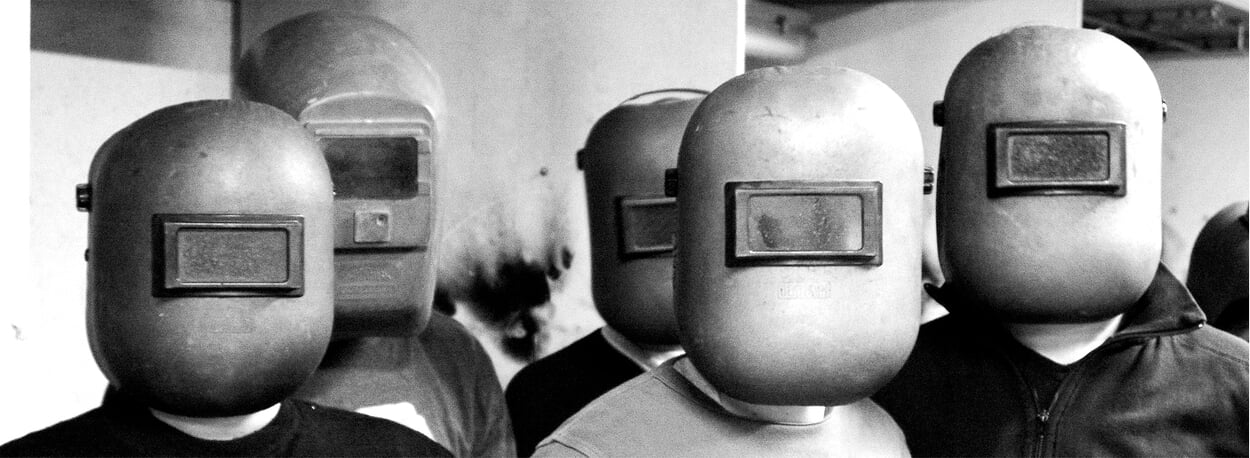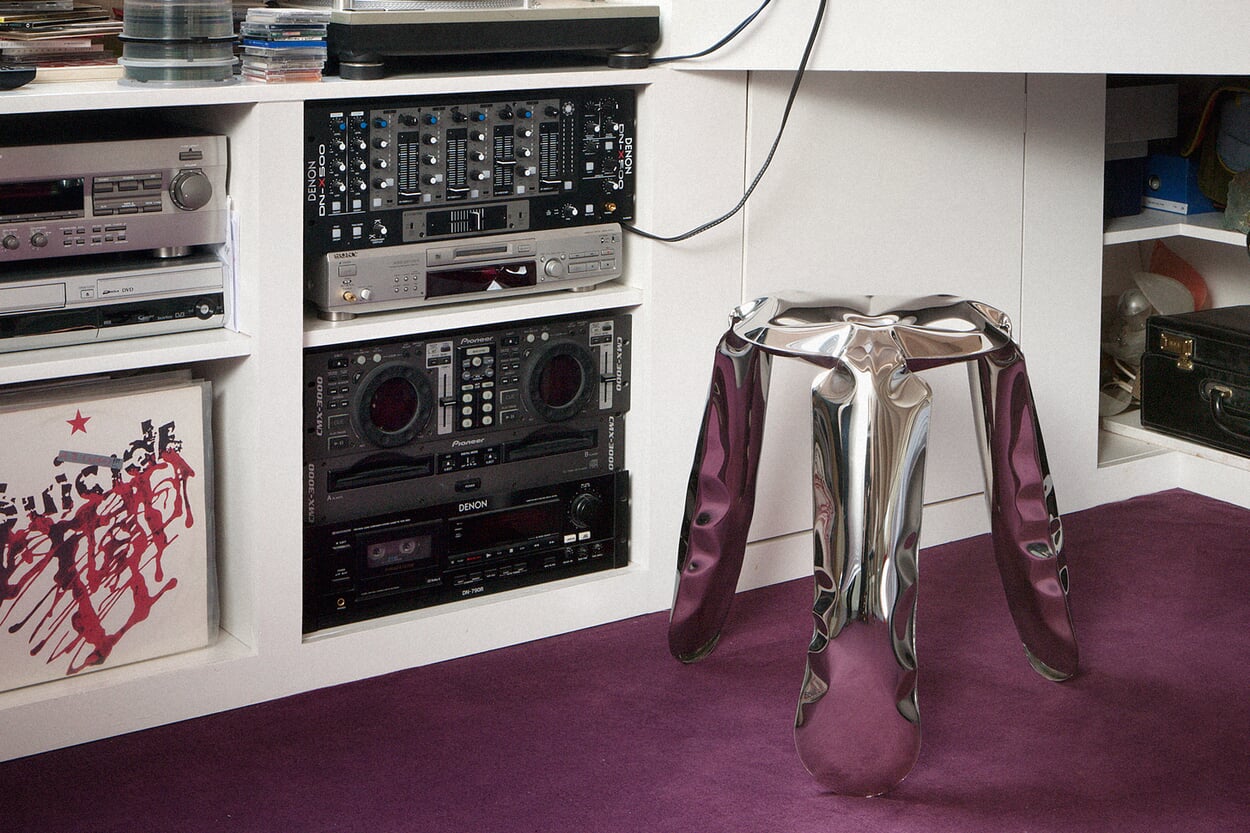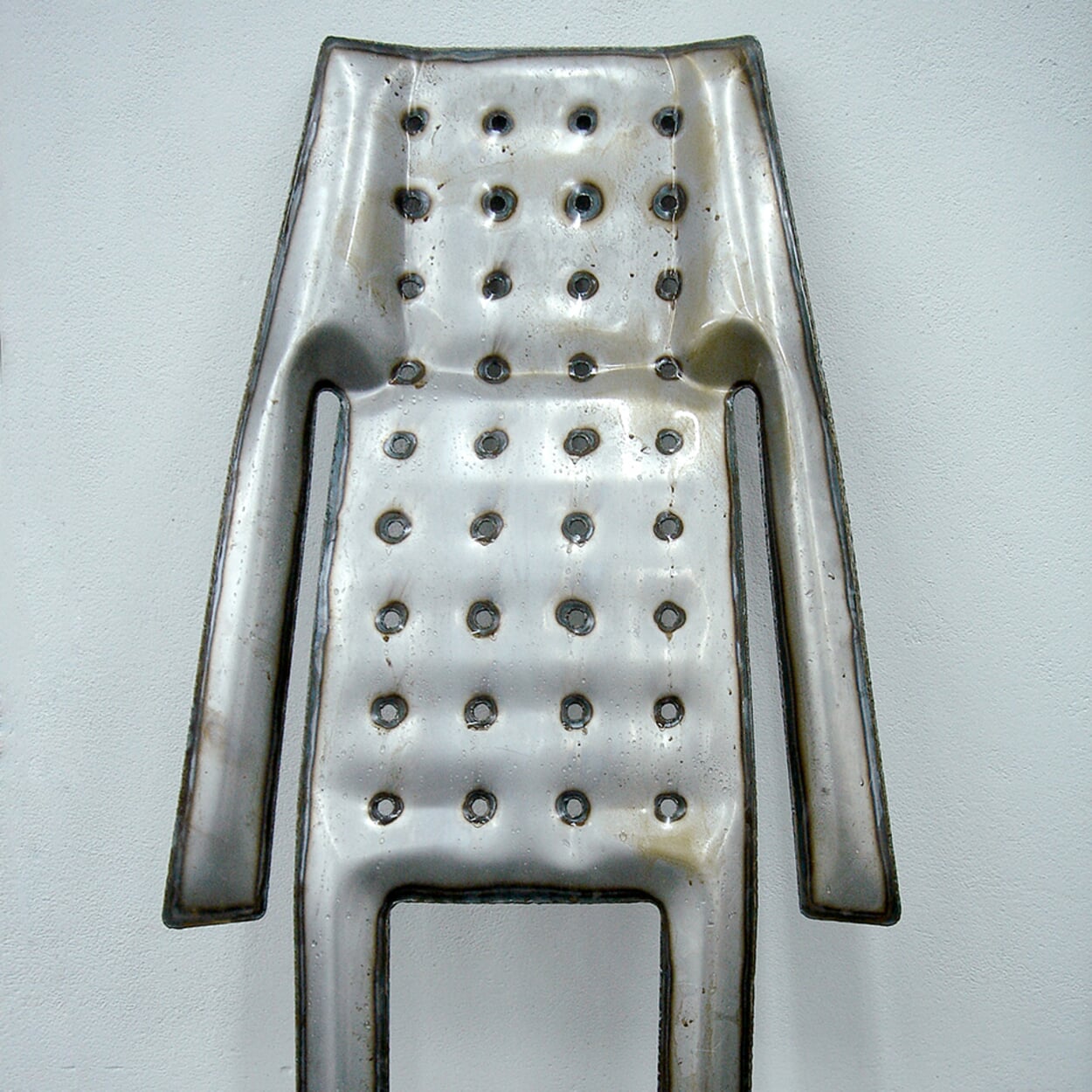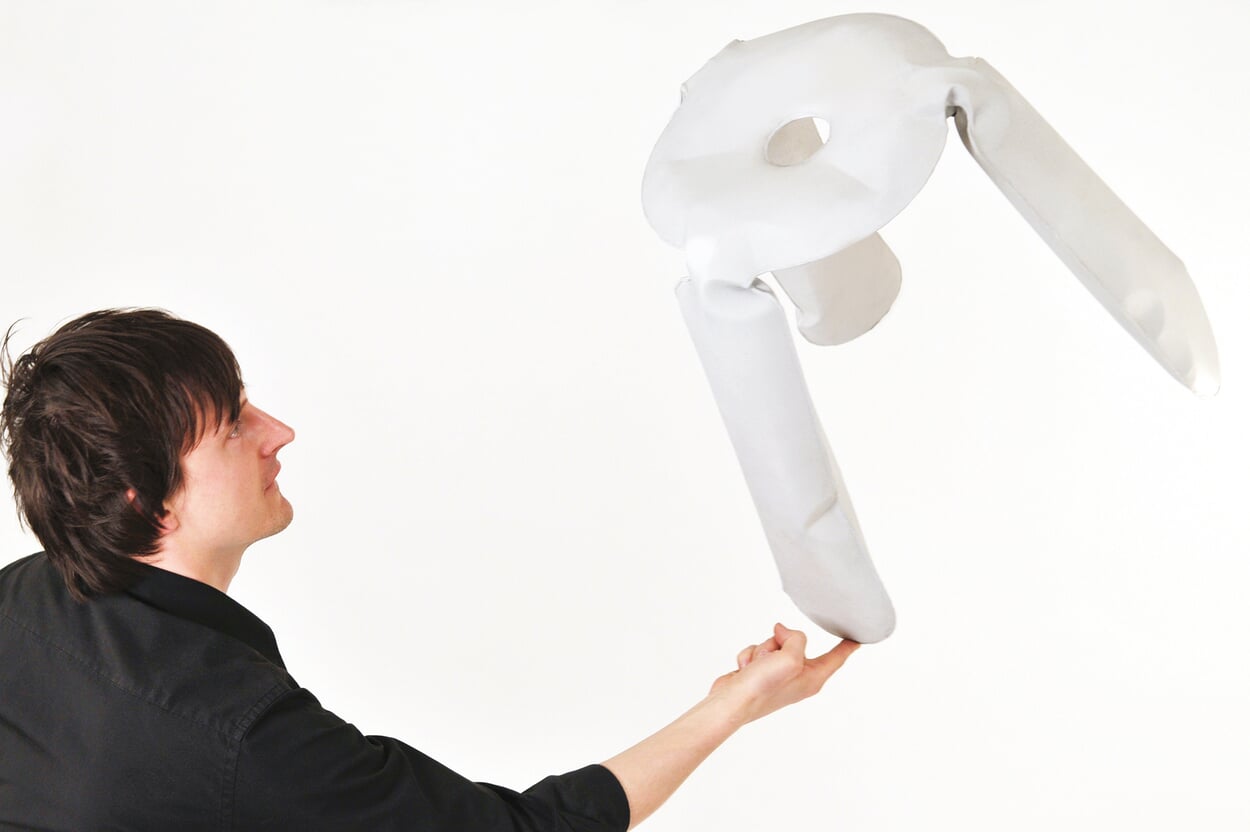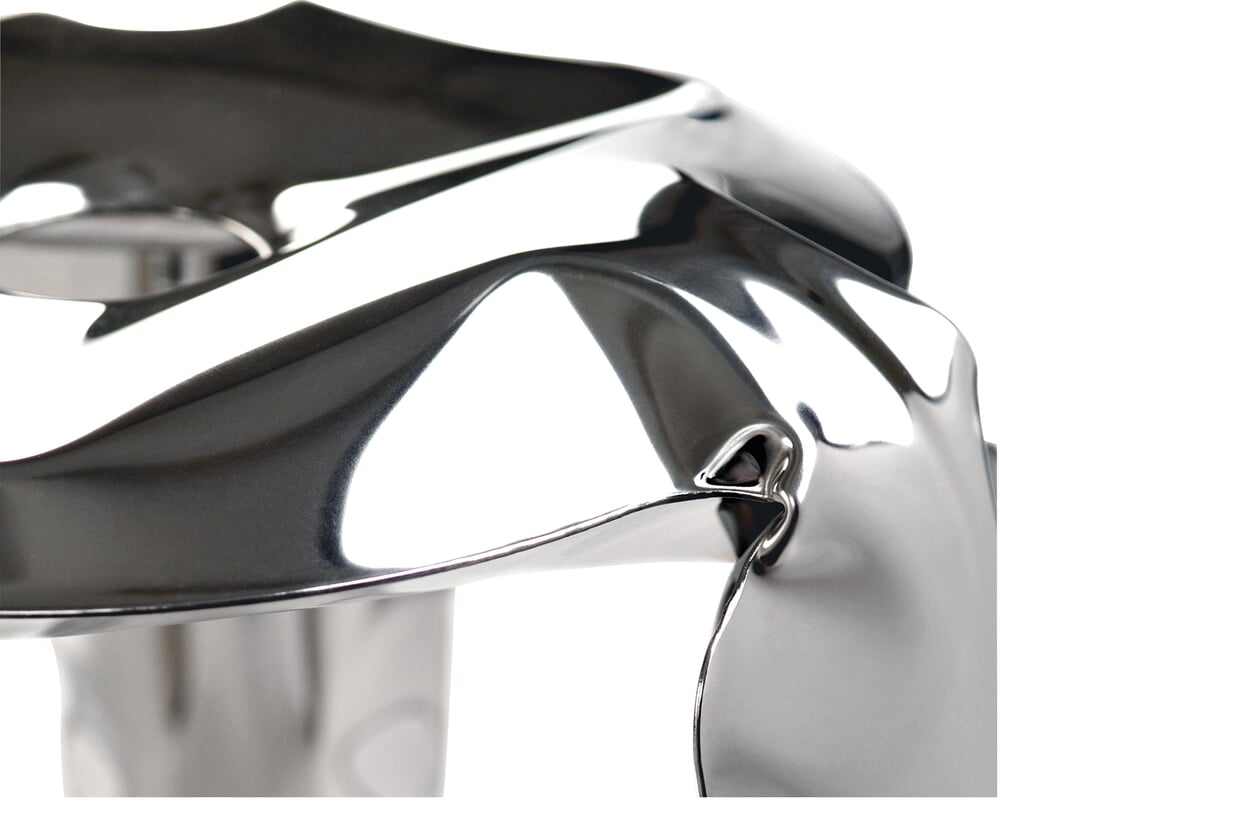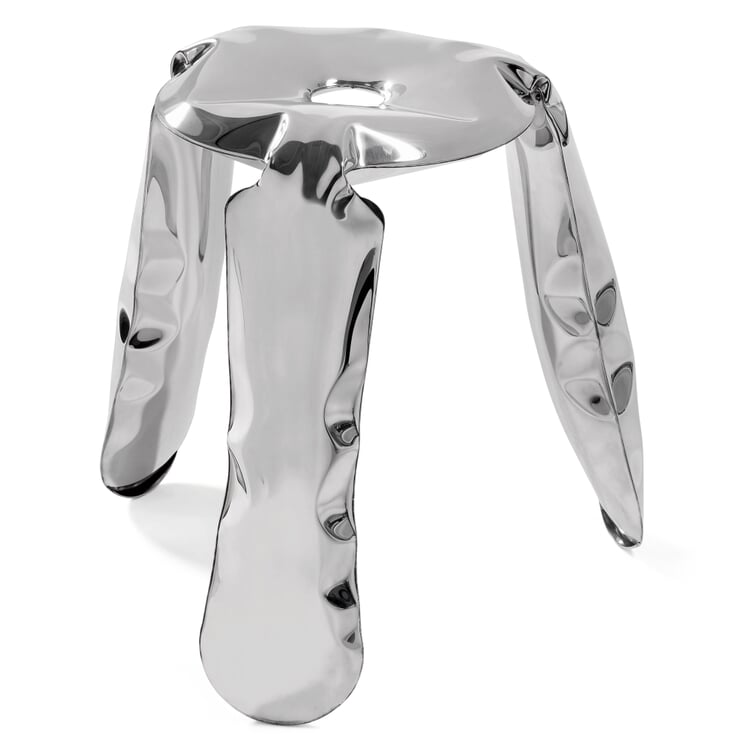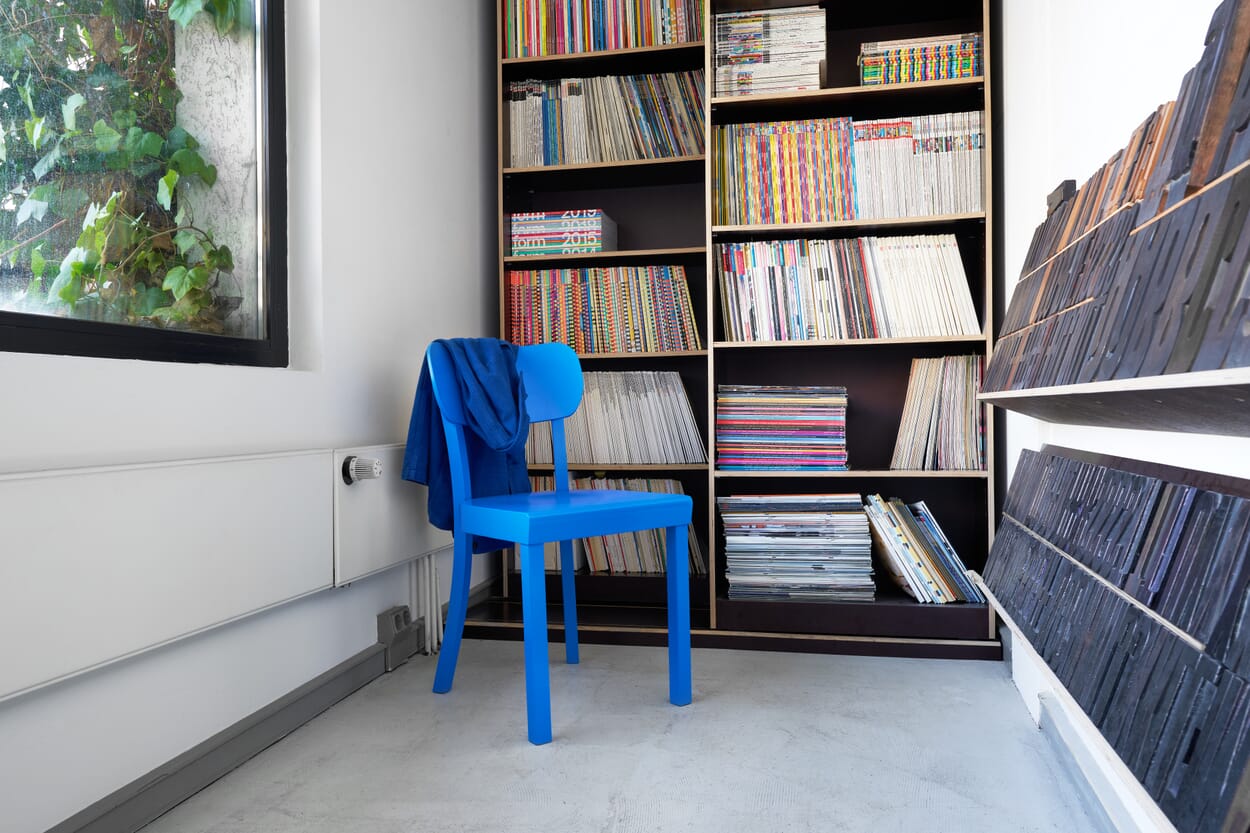Design history(ies)
Plopp stool - GENIEL AUFGEBLASEN
The Polish architect Oskar Zieta describes himself as a process designer. His role models include Jean Prouvé, one of the outstanding designers of the 20th century, who transferred production techniques from industry to architecture and design without sacrificing the aesthetic quality of the result. After studying architecture and completing his doctorate at ETH Zurich, Zieta founded a company for digital sheet metal processing in Poland, with which he conducts research and develops processes and products in a wide variety of areas. Who knows which of his designs will actually make their way into space.
If the futuristic, playful look of this stool makes you think of a stranded UFO at first glance, you're not entirely wrong. It would definitely have the best prerequisites for a journey into space. PLOPP is its name and this already reveals part of its manufacturing history, which really does open up a new horizon. PLOPP consists of two ultra-thin steel sheets that are welded together at their edges and inflated under pressure to form a 3D object. A precision landing in terms of design technology. FIDU (free internal pressure forming) is the name of the process developed by Oskar Zieta, which breaks new ground in shaping.
While sheet metal has only ever had to adapt to external pressure and function in a targeted manner since the 18th century, FIDU has given it a new inner life that is full of freedom and surprises. "I don't think about shapes, but about production and technology," says Zieta, which is only apparent at second glance in his sheet metal chair.
Oskar Zieta
Chippensteel chair
Chippensteel chair raw
The hole in the seat is particularly eye-catching, reminiscent of an air mattress or salty crackers, and is created thanks to digital laser technology and precise welding seams. When air is then injected between the metal sheets, they inflate into a cushion around the hole. The objects produced in this way are not only light, but also particularly stable. Just think of the static properties of a crumpled sheet of paper and the effect of the deformation becomes clear. What's more, they require a minimum of material and no tools at all. Even if each sheet is cut identically, each process creates a unique piece. A fascinating insight that enables mass production with an individual shape. PLOPP has not only been exhibited all over the world and won numerous awards, the first 100 units of this invention were manufactured for MAGAZIN. An exciting journey into new worlds and the beginning of a long friendship.
"For me, the material and its processing are the most important starting points. I want the final object to be a logical result of the technology. This development is always subject to honest and transparent sustainability, production time and ecological balance. I rely on technologies that enable me to produce objects in small and unique series." OSKAR ZIETA
"Architecture, design and art - you always operate in a tense relationship between these three fields. How strongly are these terms interwoven? And where are there contrasts? What characterizes your work as a crossover artist between these disciplines? Our exploration of space, the human body and new technologies moves between all the scales, and the boundaries between the disciplines are becoming increasingly blurred. It is the context of presentation, the market and reception that establish these categories. This opens up the opportunity to conduct a more diverse discussion from different perspectives."
"I learn from nature, constantly looking at it and analyzing it. When we look at ergonomic solutions, we realize that less material does not weaken the durability of structures. Many plant blueprints are based on robust outer walls formed by internal pressure, and I apply the same method to freeform to stabilize membrane-like steel objects. I hope to encourage other designers to take a similar stance and move away from a standardized, formal approach." OSKAR ZIETA
This text is an excerpt from the book "50 Jahre 50 Produkte - Designgeschichte(n) erzählt von MAGAZIN". Now available.
Plopp stool
Stool, sculpture - unmistakable object. PLOPP is produced using a spectacular technique known as FIDU (free internal pressure forming), invented by architect Oskar Zieta during his time at the ETH in Zurich. Two wafer-thin steel plates welded together at the edges are inflated with air pressure. Each of the resulting shapes in this highly polished material is a fascinating individual piece, slightly different from one another. We are delighted to have been involved in the development of this pioneering and now award-winning technology, as the first series of 100 pieces was produced by Oskar Zieta on behalf of MAGAZIN.
MAGAZIN1971
The book for MAGAZIN! 50 years of MAGAZIN encourages a special look at themes and products, stories and current affairs. Founded in Stuttgart in 1971, MAGAZIN has experienced and written history. Companions and contemporaries, product designers, customers and lovers of the brand have their say on what has happened. A collection of essays, e.g. by Sibylle Berg on "Schöner Wohnen" and Maxim Biller on "Erinnerungen von Morgen", meets contemporary topics on product design, design and furnishing. Supplemented by a special look at 50 exemplary products from the history of MAGAZIN. Including the popular and the little-seen, highlights and the inconspicuous, the favorite products of MAGAZINS and their background stories. 21x25 cm, 248 pages with many b/w and color illustrations, bound in fine linen Duchesse. Now available.
DISCOVER MORE
We are celebrating 50 years of enthusiasm for our products and selected range. Look forward to glimpses into our digital and analog shop windows.
In Stuttgart, 50 years ago, MAGAZIN was born. A store, an idea, a program formed an innovative company with stubbornness and perseverance.
Design history(ies)
Plopp stool - GENIEL AUFGEBLASEN
The Polish architect Oskar Zieta describes himself as a process designer. His role models include Jean Prouvé, one of the outstanding designers of the 20th century, who transferred production techniques from industry to architecture and design without sacrificing the aesthetic quality of the result. After studying architecture and completing his doctorate at ETH Zurich, Zieta founded a company for digital sheet metal processing in Poland, with which he conducts research and develops processes and products in a wide variety of areas. Who knows which of his designs will actually make their way into space.
If the futuristic, playful look of this stool makes you think of a stranded UFO at first glance, you're not entirely wrong. It would definitely have the best prerequisites for a journey into space. PLOPP is its name and this already reveals part of its manufacturing history, which really does open up a new horizon. PLOPP consists of two ultra-thin steel sheets that are welded together at their edges and inflated under pressure to form a 3D object. A precision landing in terms of design technology. FIDU (free internal pressure forming) is the name of the process developed by Oskar Zieta, which breaks new ground in shaping.
While sheet metal has only ever had to adapt to external pressure and function in a targeted manner since the 18th century, FIDU has given it a new inner life that is full of freedom and surprises. "I don't think about shapes, but about production and technology," says Zieta, which is only apparent at second glance in his sheet metal chair.
Oskar Zieta
Chippensteel chair
Chippensteel chair raw
The hole in the seat is particularly eye-catching, reminiscent of an air mattress or salty crackers, and is created thanks to digital laser technology and precise welding seams. When air is then injected between the metal sheets, they inflate into a cushion around the hole. The objects produced in this way are not only light, but also particularly stable. Just think of the static properties of a crumpled sheet of paper and the effect of the deformation becomes clear. What's more, they require a minimum of material and no tools at all. Even if each sheet is cut identically, each process creates a unique piece. A fascinating insight that enables mass production with an individual shape. PLOPP has not only been exhibited all over the world and won numerous awards, the first 100 units of this invention were manufactured for MAGAZIN. An exciting journey into new worlds and the beginning of a long friendship.
"For me, the material and its processing are the most important starting points. I want the final object to be a logical result of the technology. This development is always subject to honest and transparent sustainability, production time and ecological balance. I rely on technologies that enable me to produce objects in small and unique series." OSKAR ZIETA
"Architecture, design and art - you always operate in a tense relationship between these three fields. How strongly are these terms interwoven? And where are there contrasts? What characterizes your work as a crossover artist between these disciplines? Our exploration of space, the human body and new technologies moves between all the scales, and the boundaries between the disciplines are becoming increasingly blurred. It is the context of presentation, the market and reception that establish these categories. This opens up the opportunity to conduct a more diverse discussion from different perspectives."
"I learn from nature, constantly looking at it and analyzing it. When we look at ergonomic solutions, we realize that less material does not weaken the durability of structures. Many plant blueprints are based on robust outer walls formed by internal pressure, and I apply the same method to freeform to stabilize membrane-like steel objects. I hope to encourage other designers to take a similar stance and move away from a standardized, formal approach." OSKAR ZIETA
This text is an excerpt from the book "50 Jahre 50 Produkte - Designgeschichte(n) erzählt von MAGAZIN". Now available.
Plopp stool
Stool, sculpture - unmistakable object. PLOPP is produced using a spectacular technique known as FIDU (free internal pressure forming), invented by architect Oskar Zieta during his time at the ETH in Zurich. Two wafer-thin steel plates welded together at the edges are inflated with air pressure. Each of the resulting shapes in this highly polished material is a fascinating individual piece, slightly different from one another. We are delighted to have been involved in the development of this pioneering and now award-winning technology, as the first series of 100 pieces was produced by Oskar Zieta on behalf of MAGAZIN.
MAGAZIN1971
The book for MAGAZIN! 50 years of MAGAZIN encourages a special look at themes and products, stories and current affairs. Founded in Stuttgart in 1971, MAGAZIN has experienced and written history. Companions and contemporaries, product designers, customers and lovers of the brand have their say on what has happened. A collection of essays, e.g. by Sibylle Berg on "Schöner Wohnen" and Maxim Biller on "Erinnerungen von Morgen", meets contemporary topics on product design, design and furnishing. Supplemented by a special look at 50 exemplary products from the history of MAGAZIN. Including the popular and the little-seen, highlights and the inconspicuous, the favorite products of MAGAZINS and their background stories. 21x25 cm, 248 pages with many b/w and color illustrations, bound in fine linen Duchesse. Now available.
DISCOVER MORE
We are celebrating 50 years of enthusiasm for our products and selected range. Look forward to glimpses into our digital and analog shop windows.
In Stuttgart, 50 years ago, MAGAZIN was born. A store, an idea, a program formed an innovative company with stubbornness and perseverance.

